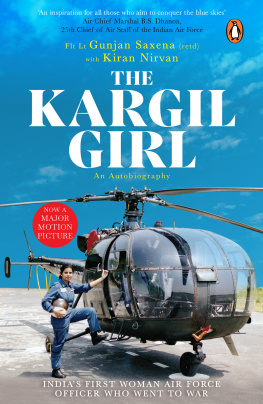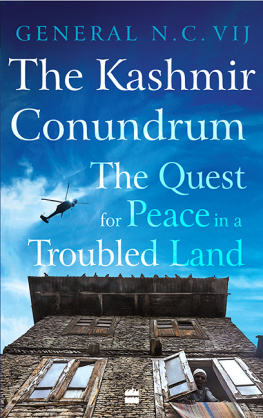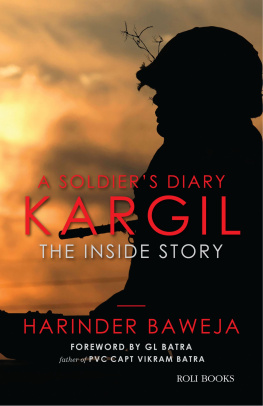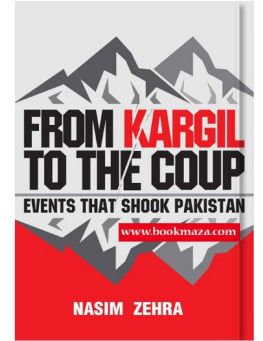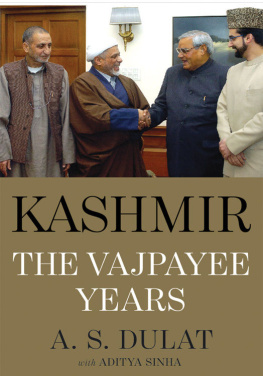KARGIL
From Surprise to Victory
General V.P. Malik

For every single brave deed noticed and recognized,
there are many that go unnoticed in the fog of war.
To those unnoticed deeds and the gallant individuals
who performed them
K ARGIL WAS A LIMITED WAR THE FIRST OF ITS KIND AFTER India and Pakistan tested their nuclear weapons. The war took place despite the fact that, only a couple of months before, both nations had signed the Lahore Declaration, an agreement recognizing the principle of building an environment of peace and security and resolving all bilateral conflicts. This type of conflict has now become a more likely operational norm in a strategic environment where large-scale capture of territories, forced change of regimes and extensive military damage to the adversary is ruled out politically.
The war will always be remembered for its strategic and tactical surprise, the self-imposed national strategy of restraint in keeping the war limited to the KargilSiachen sector, military strategy and planning, and the dedication, determination and daring junior leadership at the tactical level. In fiercely fought combat actions, on the most difficult terrain that gave immense advantage to the enemy, we were able to evict Pakistani troops from most of their surreptitiously occupied positions. The Pakistani leadership was forced to sue for ceasefire and seek withdrawal of its troops from the remaining areas. Operation Vijay the Indian codename for the war was a blend of strong and determined political, military and diplomatic actions, which enabled us to transform an adverse situation into a military and diplomatic victory. As two prime ministers of Pakistan later acknowledged, Kargil war was Pakistan's biggest blunder and disaster.
Many lessons emerged from the Kargil war, necessitating a holistic national security review as well as rethinking of the nature of conflict and conduct in the new strategic environment. Some important lessons were:
- There may be remote chances of a full-scale conventional war between two nuclear weapon states but as long as there are territory-related disputes, the adversary can indulge in a proxy war or a limited border or conventional war.
- A major military challenge in India remains political reluctance to commit a proactive engagement. This invariably leads us to a reactive military situation. Also, no loss of territory is acceptable to the Indian public and political authority. To deal with such situations, it is essential to have credible strategic and tactical intelligence and assessments, effective surveillance and close defence of the lines of control. Successful outcome of a border war depends on our ability to react rapidly in order to localize/freeze/reverse the military situation. The new strategic environment calls for speedier mobilization, versatile and flexible combat organizations and synergy amongst three services and other civil departments. A conflict may remain limited because of credible deterrence and escalation dominance. The adversary will then be deterred from escalating it into an all-out conventional or nuclear war due to our ability to respond with greater chances of success. This also gives more room for manoeuvre in diplomacy and conflict.
- A limited conventional war will require close political oversight and politico-civil-military interaction. It is essential to keep the military leadership within the security and strategic decision-making loop.
- Information operations are important due to the growing transparency of the battlefield a comprehensive media and information campaign is essential.
The armed forces appear to have followed up on most of these lessons. Action has been taken to improve all-weather surveillance and defence of the border and lines of control. Individual service and joint services doctrines have been revised. Some Special Forces units have been added to the strength of each service, though the Army is yet to review the size of its large combat formations to make them more versatile and flexible. The Kargil war had highlighted gross inadequacies in our surveillance capability. This has now been made up for with indigenous satellites and aerial imagery with synthetic aperture radar. We have also acquired effective unmanned aerial vehicles and, most important, acquired and deployed hand-held thermal imagers, surveillance radars and ground sensors along the Line of Control.
At the politico-military strategic level, however, there has been little progress. The government had carried out a National Security Review in 200102. Many reforms were recommended in this Review to improve the higher defence control organization, its systems and processes. In terms of numbers, most of these reforms are stated to have been implemented. Many changes, however, have only been cosmetic. For example, there is hardly any integration in the Ministry of Defence. I feel that we need strong, competent and committed political leadership to bring that about.
The National Security Review had recommended the appointment of a Chief of Defence Staff (CDS) to provide single-point military advice to the government and to resolve substantive inter-service doctrinal, planning, policy and operational issues. This is necessary because turf wars, inter-service rivalries, bureaucratic delays and political vacillation in decision-making become major hurdles in defence planning and its implementation. Planning in defence tends to be tardy, competitive and thus uneconomical. In the new strategic environment of unpredictability and enhanced interactivity, it is essential to create synergy and optimize defence and operational planning. A face-to-face dialogue and military advice is critical for success in politico-military-strategic and operational issues. The creation of the post of CDS is still pending and interaction between the political authority and service chiefs continues to suffer due to inter-service rivalries and the dominant position retained by the civil bureaucracy.
Modernization of the armed forces continues to lag behind due to inadequate self-reliance, fear of scams and reluctance to procure essential equipment from abroad. Despite a large network of Defence Research and Development Organization laboratories, ordnance factories and defence public sector undertakings, we continue to import 70 per cent of our weapons and equipment. The newly established Defence Procurement Board has failed to speed up the process. Instead, it seems to have added one more tier in the clearance of proposals, causing further delays. There have been no major modernization procurements for several years. Despite that, in the financial year 200809, the Ministry of Defence returned to the central exchequer Rs 7,000 crores out of the Rs 48,000 crores that had been earmarked for modernization. There is no point talking about revolution in military affairs, information systems and net-centric warfare if we cannot induct relevant weapons and equipment in time. Efforts towards modernization of the armed forces have not borne fruit adequately primarily due to the absence of holistic and long-term defence planning. It is my belief that ten years after the Kargil war, India's deterrence capability stands further eroded.
A reflection on the Kargil war can never be complete without a mention of the brilliant junior leadership that we witnessed during battles. There were countless acts of the most extraordinary valour, courage and grit to achieve what would have appeared impossible under normal circumstances. Such acts by young officers and men can never be forgotten. They make us proud. Commanding officers of many infantry battalions displayed steely resilience and single-minded devotion to duty. There were actions by young artillery forward observation officers and battery commanders who took over infantry companies when their company commander colleagues were killed. And for every single brave deed noticed and recognized, there were many that went unnoticed in the fog of war. These legendary tales deserve mention not only in our military history books but also in school textbooks to serve as inspiration for young people. We must remember that those who fight for the nation and sacrifice their lives deserve memory and recognition. It sustains their families much more than any monetary compensation. It also sustains patriotism and contributes to nation building.
Next page

